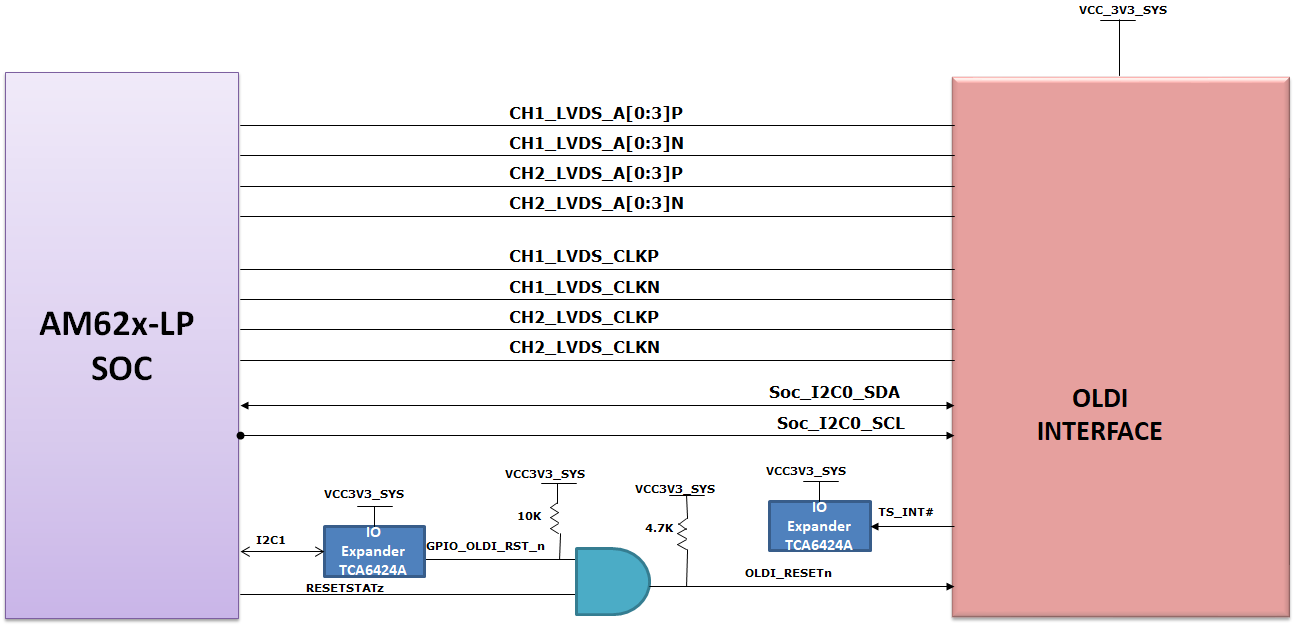SPRUJ51 june 2023
- 1
- 1Abstract
- 2EVM Revisions and Assembly Variants
- Trademarks
-
3System Description
- 3.1 Key Features
- 3.2 Functional Block Diagram
- 3.3 AM62x-Low Power SK EVM Interface Mapping
- 3.4 Power ON OFF Procedures
- 3.5
Peripheral and Major Component Description
- 3.5.1 Clocking
- 3.5.2 Reset
- 3.5.3 OLDI Display Interface
- 3.5.4 CSI Interface
- 3.5.5 Audio Codec Interface
- 3.5.6 HDMI Display Interface
- 3.5.7 JTAG Interface
- 3.5.8 Test Automation Header
- 3.5.9 UART Interface
- 3.5.10 USB Interface
- 3.5.11 Memory Interfaces
- 3.5.12 Ethernet Interface
- 3.5.13 GPIO Port Expander
- 3.5.14 GPIO Mapping
- 3.5.15 Power
- 3.5.16 AM62x-Low Power SK EVM User Setup and Configuration
- 3.5.17 Expansion Headers
- 3.5.18 Push Buttons
- 3.5.19 I2C Address Mapping
- 4Known Issues and Modifications
- 5Revision History
- 6IMPORTANT NOTICE AND DISCLAIMER
3.5.3 OLDI Display Interface
The OLDI0 Display interface of the AM62x 17x17 SoC is connected to 40 pin LVDS display connector (J22) Mfr Part # FFC2A32-40-T from GCT. The OLDI Interface supports dual channel 8 bit LVDS output. The Pin-out details of the Display connector/ are given in the table below.
 Figure 3-9 OLDI Interface Block
Diagram
Figure 3-9 OLDI Interface Block
DiagramTable 3-4 Display Connector Pinout
| Pin no. | Signal | Pin no. | Signal |
|---|---|---|---|
| 1 | VCC_3V3_SYS(EEPROM_VDD) | 21 | CH1_LVDS_A2P |
| 2 | SoC_I2C0_SCL | 22 | GND |
| 3 | SoC_I2C0_SDA | 23 | CH1_LVDS_A3N |
| 4 | NC | 24 | CH1_LVDS_A3P |
| 5 | NC | 25 | GND |
| 6 | GND | 26 | CH2_LVDS_A0N |
| 7 | GND | 27 | CH2_LVDS_A0P |
| 8 | OLDI_RESETn | 28 | GND |
| 9 | GPIO_OLDI_INT | 29 | CH2_LVDS_A1N |
| 10 | GND | 30 | CH2_LVDS_A1P |
| 11 | CH1_LVDS_A0N | 31 | GND |
| 12 | CH1_LVDS_A0P | 32 | CH2_LVDS_CLKN |
| 13 | GND | 33 | CH2_LVDS_CLKP |
| 14 | CH1_LVDS_A1N | 34 | GND |
| 15 | CH1_LVDS_A1P | 35 | CH2_LVDS_A2N |
| 16 | GND | 36 | CH2_LVDS_A2P |
| 17 | CH1_LVDS_CLKN | 37 | GND |
| 18 | CH1_LVDS_CLKP | 38 | CH2_LVDS_A3N |
| 19 | GND | 39 | CH2_LVDS_A3P |
| 20 | CH1_LVDS_A2N | 40 | GND |